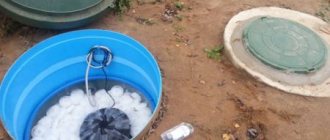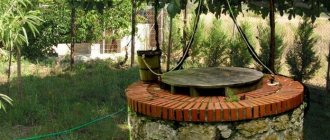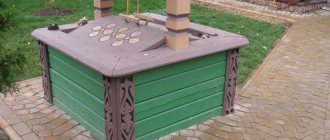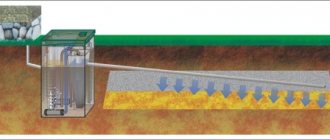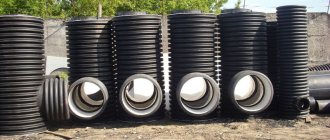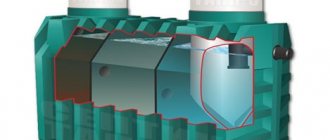How to disguise a cesspool
Whatever the sewer system, an unsightly manhole is always present. Even being very neat, it does not add beauty to the landscape, but rather resembles an eyesore rather than requiring urgent action to be taken.
And measures are taken by planting place X with climbing plants, hiding it behind a fence (at the same time, they often forget about the need to ensure free access to the structure).
A very original solution, but this flower car will have to be moved more than once (every time you need to open the hatch)
Decor of an ordinary cesspool
The vintage look of brickwork is achieved very quickly - this is facilitated by high humidity (the brick is overgrown with moss, as if by magic). But this is only possible in a primitive drainage (forbidden!) cesspool. In other situations, the brick will remain banal.
The lid is made of varnished board. The hatch is decorated with a flower arrangement located in a plastic container (easy to move). Decorating the cesspool hatch with vegetation is the most common option. And perhaps the simplest. It is not necessary to come up with something extra original - just put a garden composition on the hatch and plant ground cover plants around it.
You can do it even simpler - cover the unsightly area with rolled lawn.
Under one of these decorative stumps there is a sewer hatch.
However, these methods are good when the structure does not protrude upward, like the hatches of finished septic tanks.
Sewage treatment plant hatch
If the sewer cover “rises” above the surface, trellises and climbing plants (especially hops, thick, beautiful and growing incredibly quickly) help.
If the hatch is small, you can install a hollow decorative flowerpot (with a composition) on top. These pots are made of lightweight material - polystone. Possessing the properties of stone (strength, weather resistance), it is almost weightless and flexible in processing: wood, brick, plaster, concrete - the material is identical to any surface. It is from polystone that massive-looking but very light flowerpots, gnomes, and small architectural forms used by landscape designers are made.
Polystone is an artificial stone and is practically indistinguishable from natural stone. The hatch can be hidden under a picturesque “stone” block.
A simple but nice solution
Also the simplest thing is to install a flower bed on a hatch, and an interesting thing is to install a flower bed turned upside down (several of them nearby - and it’s not clear what the hatch is under, but it looks non-standard, aesthetically pleasing).
A couple of figures, and the sewer hatch turns into a decorative item
Behind the gate is a compost pit
This pile of compost is hiding behind a bush.
Design selection
The hatch for carrying out preventive inspections and other types of audit work can be:
- depending on installation location:
floor Such structures are characterized by the complexity of installation, since in addition to the safety margin, it is necessary to additionally ensure complete tightness of the equipment. Used when water or sewer pipes pass through the floor;
Floor inspection
ceiling As a rule, such a hatch is installed when installing a ventilation system. The main difference is the low weight of the structure;
Inspection on the ceiling
wall-mounted The most popular and frequently used type. Wall structures can be made in different sizes and shapes. No special sealing is required. There are no special requirements for the design, other than ease of use.
Inspection on the bathroom wall
- depending on the design there are:
hidden hatches. A sanitary hatch under the tile allows you to get a complete picture of the room and not stand out from the overall interior;
Hatch mounted under tiles
- open standard hatches located in the most convenient place for performing work;
- viewing windows. Any transparent material is used as a door. There is no need to open the door to receive information.
- Depending on the form there are:
- square designs;
- rectangular structures;
- designs of any other shape specified by the manufacturer.
Septic tank decor options
You can decorate manholes with natural materials or flowers. Most often, when decorating with flowers, a low box or some kind of container is selected, which is then placed on top of a hatch or septic tank. In addition to flowers, the decor can be artificial moss, climbing plants, decorative barrels, sections of wood stylized as stumps.
Of course, the most interesting solutions for decorating septic tanks are: artificial stone, shaped fiberglass lids, and figurines for the garden. These can be fairy tale heroes, three-dimensional figures, funny animals, and entire compositions. A decorative manhole cover can be a natural element. The flowerbed hatches are covered with rolled lawn, or another cover on which soil is poured. To decorate the hatch, various wooden elements are also used. You can make a wooden well, a cart, a mill, a small bridge.
It is more economical to lay a rolled lawn only in the summer, and it is better to remove it in the fall. If you use a real grass lawn, you must first pour soil onto the wooden lid or box, otherwise the grass will dry out. You can also place a low flowerpot with flowers on the lid.
Now, in a crisis, not everyone can afford expensive site decoration, so anything can be suitable for decoration: plastic bottles, barrels, used tires, materials left over from construction. The main thing is that the owners of the house like it.
Artificial stones for hatches are considered one of the most popular and durable options. Artificial stone is a decorative cover for sewer manholes. Although it looks very massive on the outside, in fact the artificial stone is not too heavy, since it is completely empty inside. Artificial stone, which can be bought in a store, is decorated with cobalt, granite, steppe boulder, sandstone, cobalt, jasper, and limestone. Such decorative stones are produced from polymers and chips of natural stones.
Around the place where the artificial stone is located, it is better to sow grass or lay a rolled lawn. This place looks good if you surround the artificial stone with plants and plant bushes nearby. Don’t forget to secure the artificial stone with fasteners to the base, or even to the ground, so that in strong winds the structure will remain in place.
DIY artificial stone master class
The stores sell a large number of designer items stylized as artificial stone. But they are expensive and fragile, as they are made of polymer resin with the addition of natural stone chips. If you accidentally step on such a “stone” - and that’s it - the product crunches. This decor for septic tanks, like artificial stone, can be done with your own hands. Artificial stone is used to hide septic tanks, sewer hatches, or unsightly places in the garden.
To work you will need:
- Wire (six wire rod).
- Metal mesh.
- Pliers.
- A can of polyurethane foam.
- Cement.
- River sand.
- Acrylic, acrylic-silicone, or oil paint.
- Brushes.
We will make an imitation of a limestone boulder. Our entire structure is mounted on a metal frame, which is made of wire rod six (springs are also made from it). A contour of any shape is made: using pliers, we bend the wire, giving it the appearance of a stone. We make an outline and attach additional edges to it. All this is welded or fastened with the same wire using pliers. All this is covered with a metal mesh. The fraction is not so important, since the main load-bearing element is construction foam. It is applied to a metal frame. Then you need to wait until the foam hardens.
After the structure has hardened, we begin to make edges using a knife, giving it the appearance of stone. After this, we dilute cement milk in a bucket, the thickness of which resembles liquid kefir. For this we take 1 part cement and 4 parts water. We impregnate our artificial stone with cement laitance using a brush. Then, after the stone has dried, we apply more cement paste with sand on top (cement - 1 part, sand - 3 parts, vrda - 0.5 parts).
This is done in order to give the product the final texture of stone. Then, after the artificial stone has dried, it can be painted with acrylic, oil, or acrylic-silicone paint. After painting, it would be a good idea to seal the structure with a layer of concrete sealant. But you can leave it without such coverage.
The video shows country house decor, including septic tank decor.
? Decor and decorations for the garden - DIY country ideas
Finally the weather is getting better. Yesterday there was sun all day, this morning! Beauty! SPRING has come...It's worrying, and even a very huge amount of snow. Let's float, however...We'll have to dig ditches and drain the water. But sooner or later everything fades away. It's time to think about sprucing up the area (I mean everything about mine). I was concerned that near the house we have two hatches - a sewer (for the septic tank and a water supply. And they stick out like an eyesore. In the most visible place, and they also “eat up” part of the territory. I turned to my dear friend - the Internet and it turns out that I’m not the only one. I’ve looked at a few ideas, I’m sharing them!
A little advertising Fortuna - St. Petersburg LLC supplies equipment and materials for water supply, heating and sewerage systems. Serious, reliable company. By ordering here РІРЋРє чугунный канализацРеонный, you will be satisfied with the speed of execution of your order. Quality guaranteed!
Manhole covers can be used as stands for indoor plants, containers with garden flowers, unusual stones, figurines, solar-powered lanterns, etc. The ground near the hatch is much warmer, so plants growing next to it rarely freeze out in winter, even in severe frosts, and are the first to bloom in early spring. Trees cannot be planted here, as there are pipes underground. And there is no need to restrict access to hatches. You can place primroses and other bulbous plants around manhole covers. Use special planting baskets, which in emergency situations can be easily removed from the ground along with all its contents. You can decorate the hatch protruding above the ground with ground cover plants and a few flat stones.
9.
How to properly decorate a sewer hatch
Decorative stone-boulder for camouflaging a sewer manhole
To decorate the sewer manholes on your site, you can buy ready-made camouflage elements or do the work yourself.
Finished products
For those who don’t want to waste time masking an unsightly hatch, there are a lot of already made elements:
- Polymer stones-boulders. They look original, withstand temperature fluctuations, and retain their presentation for a long time. The main thing is to choose the right stone diameter, color and size. Additionally, you can place a few more similar natural boulders around the site, or decorate the area by building a nice alpine slide nearby.
- Dwarfs, little men, whimsical heroes. Especially good if there are children in the house. This disguise creates the atmosphere of a fairy tale.
- Chests or wells. Unusual decor options in a certain style.
- Interesting garden bridges.
Artificial lawn grass in the form of a mat.
After purchasing the finished product, all that remains is to install it on top of the manhole cover.
DIY plant decor
Decorating with plants
There are a lot of ideas for decorating a manhole. The most popular of them:
- Planting mini-lawns on the cover. Suitable for polymer hatches that have special recesses. With this technique you can beautifully decorate even a small garden. It is advisable to place annual plants with a small root system in mini-lawns. Their color can be changed every year.
- Planting low-growing ornamental plants. They must be placed on the side from which technical maintenance work on the system is not carried out. You can use juniper or dwarf Christmas trees of the Nidiformis and Barri varieties. You can also plant irises, dotted loosestrife or caustic sedum not far from the sewer well. These are perennial crops that quickly recover from accidental mechanical impacts. A special shrub that spreads in growth, stephanandra, performs well in this regard. As it grows, it will cover the hatch. To open the well, you can simply move the branches of the crop to the sides.
Wooden decor
Stump for masking the lid
Wood is whimsical as a camouflage material. But with proper processing, a nice element will last for more than one year. Options you can use:
- Cut down a small height (stump with roots). The wood must first be prepared: dried in the sun, then coated with fire retardants and varnish. The main thing is that the cut section is slightly larger than the diameter of the lid. You can buy artificial polymer and very light stump.
- Snag. It will also look original in landscape garden design.
- Decorative well. The master can make a low house for an artificial source himself.
Wooden elements always look authentic.
Paints
Decorating a manhole with a pattern
If the sewer cover is made of cast iron and is located directly on the sidewalk path, there is only one way out - pick up a brush and disguise the element with a pattern. You can show your imagination and paint sewer disks in any theme. It could be flowers, an ornament, or just monochrome. It all depends on the talent of the master and the desire to make your yard a little brighter, more interesting, and more fun.
Hatches made of polymer-sand compositions
These covers are lightweight but highly durable. During their manufacture, a dye is introduced into such a composition. Therefore, even after a long period of use, they retain their original color. For example, they are produced in the form of imitation paving slabs.
These hatches can support a load of approximately 15 tons. They are not affected by temperature changes from +60 to -60 degrees. Their positive quality is also that its surface is not slippery. There are ready-made covers for sewer wells on sale, depicting sculptures in the form of a stump, anthill or fairy-tale characters. Miniature copies of some architectural structure look original. For example, a medieval castle.
Cover decoration elements
You can decorate septic tank covers with your own hands. Decorative elements can be:
- fake diamond;
- mobile flower bed;
- compositions of garden figurines and other additional elements.
Fake diamond
A boulder or artificial stone is a structure that is hollow inside and looks like a real stone from above. The advantages of this decor are:
- low cost;
- ease of installation. The stone is simply placed on top of the septic tank lid;
Masking the septic tank lid with artificial stone
- light weight, which allows you to remove the decorative element in the shortest possible time and without outside help for periodic maintenance of the treatment plant;
- non-susceptibility of the material to temperature changes and precipitation. The product service life is more than 25 years;
- a variety of shapes and colors, which allows you to choose the best option for the landscape of your garden plot.
You can make a stone for decorating the septic tank lid yourself. To do this you will need to prepare:
- cement mortar;
- special shape (you can use any shape, for example, a car tire);
- stone chips.
The manufacturing process is as follows:
- the bottom of the shape of the future boulder is covered with small stones or crumbs;
- the crumb is poured with concrete;
- After the cement mortar has completely dried, the boulder is removed from the mold and placed in the place prepared for it.
Decorative stone production scheme
How to make a boulder from polyurethane foam and a metal frame, watch the video.
Mobile flower bed
A decorative portable flowerbed can be made from various materials in accordance with the wishes of the owner of the site. The most commonly used:
- car tires;
- wooden boxes;
- baskets;
- umbrellas;
- barrels and so on.
Annual flowers with a small root system are planted in the prepared flowerbed frame. The finished structure is installed on the lid of the septic tank.
Mobile flower bed for decorating the lid of a septic tank
Decorating with compositions
Another decorative element can be various garden figurines, which can be purchased in stores or made from scrap materials with your own hands.
Figurines for decoration
Finished figurines are usually made of polymers and differ in:
- resistance to temperature changes;
- resistance to sunlight;
- resistance to precipitation.
From ready-made figurines you can build various compositions using decorative stone and/or a portable flower bed.
Artificial stone lid with garden figurine and plant
So, it is mandatory to install a cover at a wastewater treatment plant. To prevent the lid from spoiling the appearance of the area, it can be decorated with various elements in accordance with the overall design concept. Using various decorative elements, you can also “hide” filtration fields, sewer pipes, inspection and inspection wells, and so on.
Septic tank covers purpose and types
A reliable lid covering the septic tank performs the following functions:
- Protects the container from melt and rain water and debris.
- Prevents the spread of unpleasant odor throughout the area.
- Helps protect children and pets from injury when falling into an open container.
- Prevents the penetration of sunlight into the container, which is fraught with the active proliferation of harmful microorganisms.
When purchasing an industrial septic tank (metal or plastic), you don’t have to worry about the availability and compatibility of the lid. It comes included.
Plastic septic tank with lid
To build septic tanks with your own hands, use reinforced concrete rings or bricks. In this case, you will have to do the selection or manufacture of the cover yourself. The traditional option is a reinforced concrete “pancake” with a metal hatch.
Wooden shield cover
Standard industrial lids do their job well, but they can hardly be called examples of aesthetics and originality. In some cases, their appearance can seriously spoil the impression of the surrounding landscape. The solution to the problem is decorative options, both ready-made and homemade.
DIY septic tank decor
You don’t have to spend money on decorative elements, but try to make the lid yourself.
The material for this is selected whatever is at hand. Just be sure to provide the ability to move the lid when cleaning needs to be done. It is best to use old tires for this. Having selected the most suitable tire in diameter, install it on the hatch, securing the cellophane on the bottom side in advance. After this, soil is poured inside the tire and flowers with a shallow root system are planted. If such a desire arises, the outer surface of such a flower bed can be painted in any color or decorated with small pebbles. This homemade septic tank decor will wonderfully decorate a suburban area.
You can also make a structure in the form of a hemisphere from wire. It should hinge in the same way as the hatch cover. Decorate it with flowers or climbing ornamental plants.
Dry stream
This method of decoration is preferable to use for septic tanks with filtration fields. The stream is laid out from natural materials. It can be one of the elements of an alpine slide. To make such a stream, it is not necessary to take an expensive natural stone - you can buy ordinary river pebbles.
If you don’t have extra money to purchase decorative septic tanks, then you can make them yourself, using leftover building materials, uprooted stumps or decorated old barrels.
Cover-flower bed
The septic tank cover for a private home can be located not only in the middle of the lawn, but also in the flower garden. In this case, you can disguise it in several ways. The fastest of them is installing a false flower bed. Essentially, this is a large container with soil into which annuals are planted. It is installed directly on the hatch and decorated around the edges. As such a container, you can use a basin, bucket, flowerpot, bag of soil, or a specially purchased lid with a recess.
The main thing when installing such a structure is to make it easily dismountable, because during the season you may need to open the septic tank lid several times.
How to operate a septic tank in cold weather
If you understand how a septic tank works, then the question of the need to insulate it for the winter will not arise. A septic tank has two or three tanks that are connected using overflow pipes. Bacteria that process wastewater multiply in the septic tank. To prevent microorganisms from dying, it is necessary to maintain a positive temperature. The septic tank is buried below the freezing level of the ground. In this layer of soil the temperature varies within five degrees. In this case, the drains do not have time to freeze if warm sewage is constantly coming from the house.
If you use a septic tank all year round, then in winter there should be no problems with its operation and the condition of the pipes. If the pipeline is laid with an inclination towards the septic tank, then ice plugs should not appear inside the pipes. They will be heated by the constant flow of wastewater through the system.
Attention! The soil near the septic tank retains heat even in frosty conditions, as evidenced by melted snow around the perimeter of the structure.
If a septic tank is used at a dacha in the summer and is idle in the winter, then the structure must be prepared for the effects of frost. To prevent the system from freezing, it is insulated or preserved.
Decor selection criteria
Ready-made decorative hatch cover
The choice of the final camouflage option depends on several important factors:
- General style of landscape design at a summer cottage. The decorative element should fit into it and look organic.
- Manhole cover material. For polymer products, it is better to choose lighter camouflage options, although plastic mixed with a composite can withstand high loads. Excessively heavy elements can damage the surface of the sewer cover.
- The complexity of the process. If the master likes to tinker and show his imagination, you can opt for non-standard, intricate options. If you want to do everything in no time, it is recommended to simply purchase a ready-made solution.
- Durability and attractiveness of the final (final) design. The decor is not made for one or two years, so it is worth considering the material’s resistance to temperature changes, sun, and precipitation.
- Weight of the finished structure. If you need to get under the hatch cover, you will have to lift the decor. It is advisable to do without outside help. After all, at the right time it may not be there.
You should rely on your financial capabilities. For some, it is acceptable to close a sewer hatch within 50,000 rubles, while others are able to manage only a few hundred or thousand.
WHAT TO DO IF THE SEPTIC TANK IS FROZEN
There are several defrosting methods:
- Pour hot water down the drain to help melt the ice before it freezes even more.
- You can pour a concentrated solution of soda-salt mixture into the septic tank. This is the fastest and safest way to remove ice.
- Using heating devices or power cables that are wrapped around the perimeter of the septic tank, warm up the tanks. This method is the most expensive and requires professional help.
BUT be careful! Remember that sanitaryware can burst from boiling water, so pour it not on the walls, but in a small stream into the cold water of the toilet water seal.
What needs to be done
Insulation of a sewer can be done in several ways:
- insulate the hatch cover;
- insulate the walls of the well itself.
It will be better to combine both methods. In such a case, you can be completely sure that the well will not freeze during winter.
As an additional precaution, you should also take care of the thermal insulation of sewer pipes
Cover insulation
To prevent cool air from entering the well, you should take care of a high-quality cover; a concrete cover is not suitable for use in winter. It would be right to purchase a ready-made insulated product. If this does not work, you can make a similar cover without outside help.
To do this you will need:
- wooden boards or two sheets of stainless metal;
- expanded polystyrene.
Everything is made extremely simply: you make a lid of the required shape and size from wood (or metal). It should close the drain well hatch very tightly.
Attach polystyrene foam to the resulting lid and cover it with another layer of wood. This cover is extremely simple to design, but it protects the sewer well from frost.
If possible, you can make a small decorative house that will cover the above-ground part of the well, protecting it from frost. The easiest way to make such a wooden house. First of all, it is very easy, and second, the material does not require additional insulation.
Wall insulation
As we have already said, it is best to insulate the walls of the septic tank during installation.
For example, let’s take a well made of concrete rings, since this particular tone is considered very popular.
The main sequence of actions is as follows:
- There must be a hole around an already installed well, the width of which is up to 0.5 m.
- The insulation of a simple well with penoplex is shown. The lower ring is carefully covered with thermal insulating material. This can be polystyrene shell, expanded polystyrene. The selection depends only on you. The gaps between sheets of insulation material must be sealed with installation foam. After which the heat insulator should be covered with a layer of plaster and protection from the negative effects of moisture.
- We insulate the rest of the well in the same way.
If you plan to insulate a structure that has been installed for a long time, you will need to dig a pit with a depth of at least 1.5 meters near it and thermally insulate this part.
The main thing: 1.5 m is the average depth of freezing of the ground, therefore you should not limit yourself to insulating only the upper ring of concrete.
Conclusion
Insulating a sewer well is very simple. The process does not take a lot of time and effort, and does not require expensive materials. But thanks to high-quality thermal insulation, your sewer system can last longer.
How to make a cesspool cover from concrete
There is a need for invention, so the lids, and with them the hatches, are made from boards, metal sheets and other flat materials. However, a loosely fitting lid shows a steady tendency to leak sewer aromas, which does not delight even those who made this part.
To prevent smells from intruding as an inappropriate note into the melody of country life, tightness is required. The lid is the most complex element of a cesspool made of concrete. If pouring the bottom, assembling the formwork and casting the walls, although labor-intensive, is not technologically difficult (the formwork has a support), then you have to make the lid by weight.
The work is somewhat simplified by a corrugated sheet. They write that it even increases strength, but a logical question arises - why strength if they do not intend to put heavy machines or other loads on the lid. However, these are lyrics. It’s really much more convenient with a sheet of corrugated board.
The first step is to cover the pit - install the boards end-to-end so that the lid extends 20–30 cm beyond the walls (so that the weight load is partially on the ground). Instead of boards, the pit can be covered with profile pipes and a steel angle (high load-bearing capacity - concrete weighs a lot).
Overlap
Planks or a sheet of corrugated sheeting are laid flat on the roofing (corrugated sheeting is a permanent part, which also simplifies the process) and the formwork is assembled, not forgetting about the holes for the hatch and communications. Then a reinforcing mesh is knitted (or welded) (reinforcement - 12 mm, pitch - 15–20 cm), and then poured with concrete.
Pouring concrete
Another option is to cast the slab separately and then install it on the walls. In this case, all communications are connected and waterproofing work is carried out before installing the cover.
Monolithic construction and in Africa - monolithic construction. They build it the same way everywhere. The guys made a very nice scavenger hunt. They cast the cover separately (not forgetting about the mounting brackets) and before installing it, they connected all the pipes and made waterproofing.
When deciding in favor of a monolithic pit, keep in mind that concrete dries for 28 days (ideally) and all this time you need to create optimal conditions for it.
All of the above also answers the question of how to make a lid for a cesspool out of brick.
Materials for making the lid
To make the lid, you can use a wide variety of building materials, which are most suitable in each specific case:
- Tree.
- Metal.
- Plastic.
- Plywood.
- Chipboard.
The most common option in the recent past is a wooden lid. This material is environmentally friendly, affordable and easy to process. Also, the wooden structure above the well looks very colorful and original, especially if the homeowner uses imagination when decorating the log house. You can also cut a hinged lid from sheet metal, polymer sheets - hardboard, textolite, installed on a wooden or steel frame.
If the well shaft is made of concrete casing rings, then you don’t have to worry too much and cover it with a standard concrete cover with a hatch. Of course, such a structure will not look very aesthetically pleasing. But, if the well is located deep in the garden plot and is not noticeable to guests and household members, this option is quite acceptable. The main advantage in this case is the simplicity of the device and durability of operation.
Types of hatches for treatment systems
There can be many options for how to close a septic tank. Of course, not all of them are decorative, but if desired, even an ordinary wooden panel laid on a sewer hatch can be turned into a panel.
Decorative products for hatches
There are several types of septic tank covers. They vary depending on the type of septic tank and are:
- Plastic
- From stone chips
- Reinforced concrete
The first type of cap is usually used with standard industrial models of cleaning systems.
However, it will also be appropriate in home-made structures made from Eurocubes. Since usually the upper part of such a septic tank has a hole with a lid, but if it is small, then it is always possible to cut a larger one in diameter. And the first option is ideal for closing it.
If a septic tank with concrete rings is installed on your site, then it should be closed with a reinforced concrete lid in which a hatch is built in. Such models were previously used everywhere, but today they are being replaced by plastic.
Concrete products
However, the septic tank itself can be closed with any other product that is suitable in size. However, this option, in addition to having poor external qualities, can also be dangerous for others.
Of course, in a critical situation, you can also use a shield made of boards. But the problem with such a cover is its short service life.
Wood that comes into contact with liquid will very quickly become unusable. Therefore, plastic is still the ideal option.
Interesting wood decor ideas
If the type of stones does not match the personal taste preferences of the owner of the summer cottage, then you can use a more beautiful material - wood. Besides, finding some kind of snag or stump is not so difficult. Otherwise, they, like artificial boulders, can be purchased in the store. In appearance, decorative stumps do not differ from real wood, and they have a fairly long service life. In addition, artificial products specially provide platforms or recesses for flower pots. In any case, each gardener will decide for himself whether he prefers the look of natural or artificial decor.
If you use your imagination, you can make various shapes from wood. For example, you can throw a small bridge over the lid. It is ideal when a stone stream approaches the well.
We use an old barrel for decoration:
If there is an old barrel that has already fallen apart, then it will make a good lid, and one made with your own hands.
- First you need to cut the wooden tub in the middle or a little lower and let it dry well.
- Then you should tighten the boards, stepping back a little from the cut line, using thick copper wire.
- After this, the product must be treated with a special antiseptic composition and then covered with drying oil. For greater reliability, several layers - 3-4 will be enough. This will protect the tree from rotting.
WHAT IF YOU NEED A SEPTIC TANK ON WEEKENDS IN WINTER?
Winter preservation of the septic tank is necessary if the house is left for more than a month. If you plan to come every 2-3 weeks in the winter and the power is not turned off, you can do without conservation, since the treatment facilities will survive the winter just fine.
Most septic tanks tolerate the absence of wastewater well for two weeks, while the vital activity of bacteria remains at a level sufficient for their reproduction and operation. Since the system consumes a small amount of electricity, the bill issued to you by the energy company will not increase significantly, but your dacha will be comfortable in winter.
